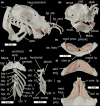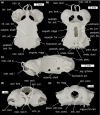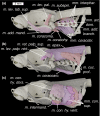The morphology and evolution of chondrichthyan cranial muscles: A digital dissection of the elephantfish Callorhinchus milii and the catshark Scyliorhinus canicula
- PMID: 33415764
- PMCID: PMC8053583
- DOI: 10.1111/joa.13362
The morphology and evolution of chondrichthyan cranial muscles: A digital dissection of the elephantfish Callorhinchus milii and the catshark Scyliorhinus canicula
Erratum in
-
Corrigendum.J Anat. 2021 Oct;239(4):972. doi: 10.1111/joa.13498. Epub 2021 Jul 26. J Anat. 2021. PMID: 34312847 Free PMC article. No abstract available.
Abstract
The anatomy of sharks, rays, and chimaeras (chondrichthyans) is crucial to understanding the evolution of the cranial system in vertebrates due to their position as the sister group to bony fishes (osteichthyans). Strikingly different arrangements of the head in the two constituent chondrichthyan groups-holocephalans and elasmobranchs-have played a pivotal role in the formation of evolutionary hypotheses targeting major cranial structures such as the jaws and pharynx. However, despite the advent of digital dissections as a means of easily visualizing and sharing the results of anatomical studies in three dimensions, information on the musculoskeletal systems of the chondrichthyan head remains largely limited to traditional accounts, many of which are at least a century old. Here, we use synchrotron tomographic data to carry out a digital dissection of a holocephalan and an elasmobranch widely used as model species: the elephantfish, Callorhinchus milii, and the small-spotted catshark, Scyliorhinus canicula. We describe and figure the skeletal anatomy of the head, labial, mandibular, hyoid, and branchial cartilages in both taxa as well as the muscles of the head and pharynx. In Callorhinchus, we make several new observations regarding the branchial musculature, revealing several previously unreported or ambiguously characterized muscles, likely homologous to their counterparts in the elasmobranch pharynx. We also identify a previously unreported structure linking the pharyngohyal of Callorhinchus to the neurocranium. Finally, we review what is known about the evolution of chondrichthyan cranial muscles from their fossil record and discuss the implications for muscle homology and evolution, broadly concluding that the holocephalan pharynx is likely derived from a more elasmobranch-like form which is plesiomorphic for the chondrichthyan crown group. This dataset has great potential as a resource, particularly for researchers using these model species for zoological research, functional morphologists requiring models of musculature and skeletons, as well as for palaeontologists seeking comparative models for extinct taxa.
Keywords: Callorhinchus milii; Scyliorhinus canicula; cranial muscles; digital dissection; elasmobranch; holocephalan.
© 2021 Anatomical Society.
Figures












Similar articles
-
Holocephalan embryos provide evidence for gill arch appendage reduction and opercular evolution in cartilaginous fishes.Proc Natl Acad Sci U S A. 2011 Jan 25;108(4):1507-12. doi: 10.1073/pnas.1012968108. Epub 2011 Jan 10. Proc Natl Acad Sci U S A. 2011. PMID: 21220324 Free PMC article.
-
Myological variability in a decoupled skeletal system: batoid cranial anatomy.J Morphol. 2014 Aug;275(8):862-81. doi: 10.1002/jmor.20263. Epub 2014 Mar 21. J Morphol. 2014. PMID: 24652648
-
The pharynx of the stem-chondrichthyan Ptomacanthus and the early evolution of the gnathostome gill skeleton.Nat Commun. 2019 May 3;10(1):2050. doi: 10.1038/s41467-019-10032-3. Nat Commun. 2019. PMID: 31053719 Free PMC article.
-
Specialize or risk disappearance - empirical evidence of anisomerism based on comparative and developmental studies of gnathostome head and limb musculature.Biol Rev Camb Philos Soc. 2015 Aug;90(3):964-78. doi: 10.1111/brv.12142. Epub 2014 Aug 30. Biol Rev Camb Philos Soc. 2015. PMID: 25174804 Review.
-
Reconstructing the subcephalic musculature in Pucapampella and Ichthyostega.J Morphol. 2023 Dec;284(12):e21648. doi: 10.1002/jmor.21648. J Morphol. 2023. PMID: 37990766 Review.
Cited by
-
Early shape divergence of developmental trajectories in the jaw of galeomorph sharks.Front Zool. 2022 Feb 5;19(1):7. doi: 10.1186/s12983-022-00452-1. Front Zool. 2022. PMID: 35123488 Free PMC article.
-
Shark mandible evolution reveals patterns of trophic and habitat-mediated diversification.Commun Biol. 2023 May 8;6(1):496. doi: 10.1038/s42003-023-04882-3. Commun Biol. 2023. PMID: 37156994 Free PMC article.
-
Three-dimensional fossils of a Cretaceous collared carpet shark (Parascylliidae, Orectolobiformes) shed light on skeletal evolution in galeomorphs.R Soc Open Sci. 2025 Apr 30;12(4):242011. doi: 10.1098/rsos.242011. eCollection 2025 Apr. R Soc Open Sci. 2025. PMID: 40309188 Free PMC article.
-
Evidence for high-performance suction feeding in the Pennsylvanian stem-group holocephalan Iniopera.Proc Natl Acad Sci U S A. 2023 Jan 24;120(4):e2207854119. doi: 10.1073/pnas.2207854119. Epub 2023 Jan 17. Proc Natl Acad Sci U S A. 2023. PMID: 36649436 Free PMC article.
-
The Palaeozoic assembly of the holocephalan body plan far preceded post-Cretaceous radiations into the ocean depths.Proc Biol Sci. 2024 Oct;291(2033):20241824. doi: 10.1098/rspb.2024.1824. Epub 2024 Oct 30. Proc Biol Sci. 2024. PMID: 39471859
References
-
- Allis, E.P. (1897) The cranial muscles of Amia . Journal of Morphology, XII, 489–772.
-
- Allis, E.P. (1917) The homologies of the muscles related to the visceral arches of the gnathostome fishes. Quarterly Journal of Microscopical Science, 62, 303–406.
-
- Anderson, P.S.L. (2008) Cranial muscle homology across modern gnathostomes. Biological Journal of the Linnean Society, 94, 195–216.
Publication types
MeSH terms
LinkOut - more resources
Full Text Sources
Other Literature Sources

